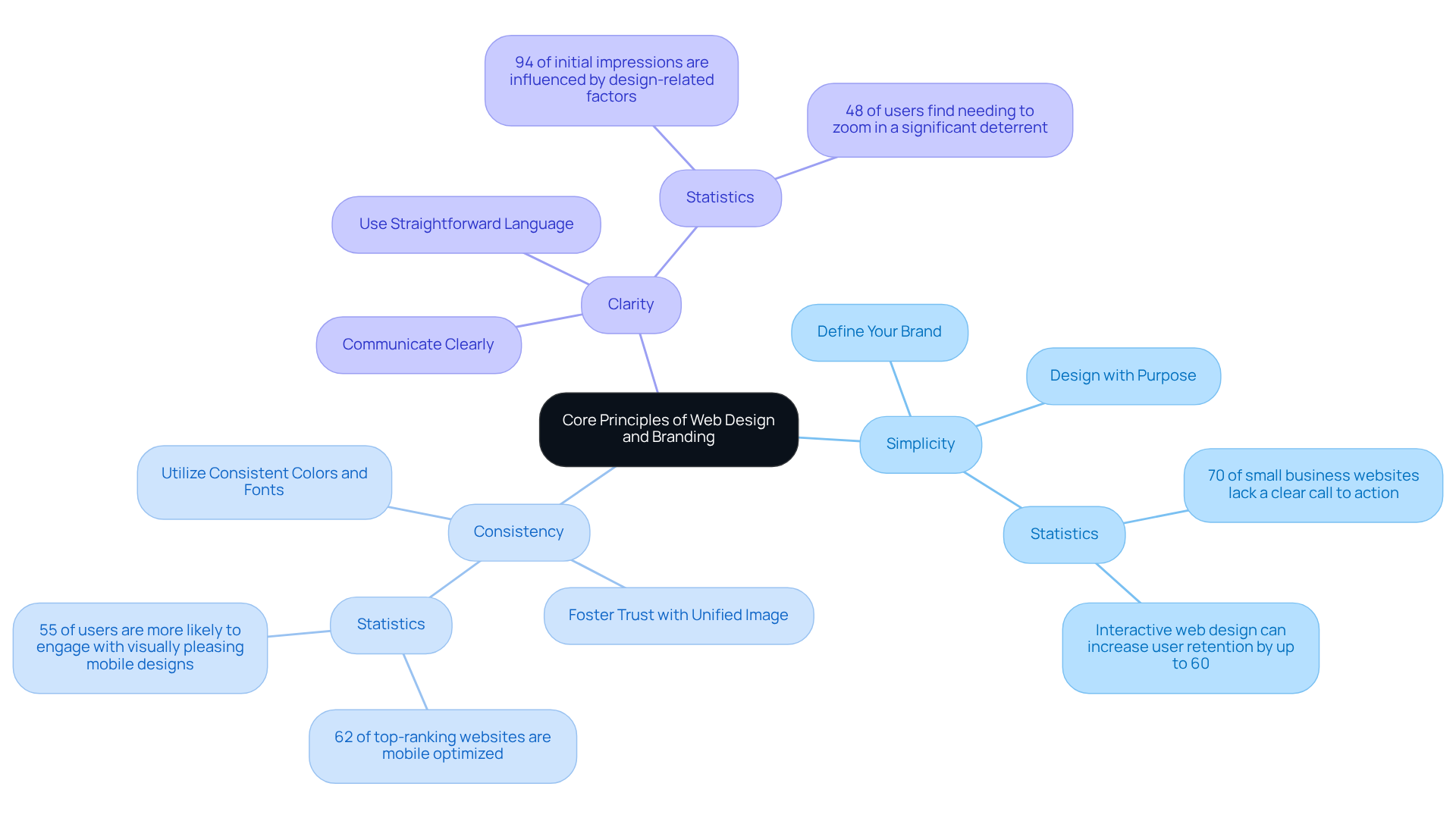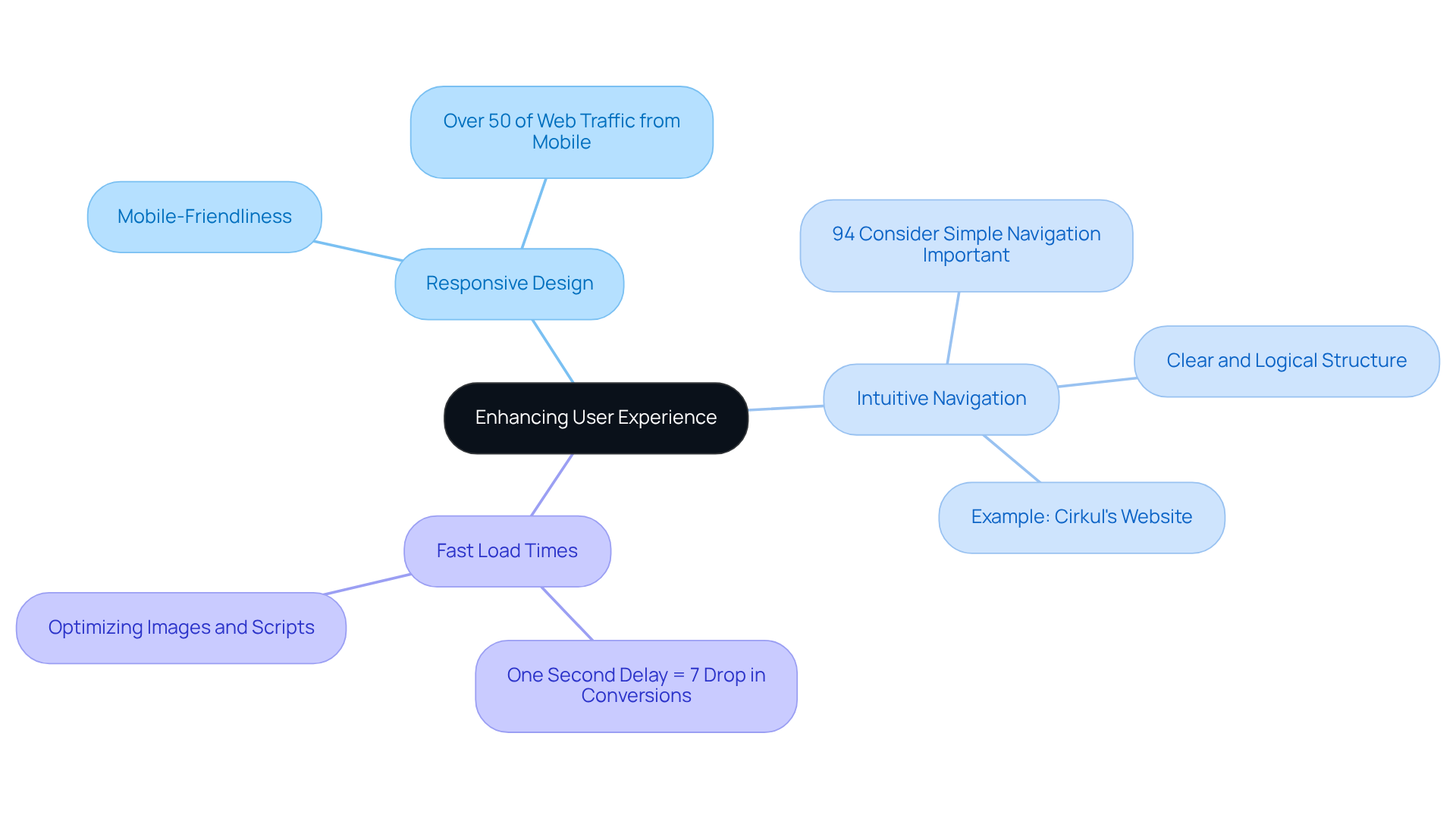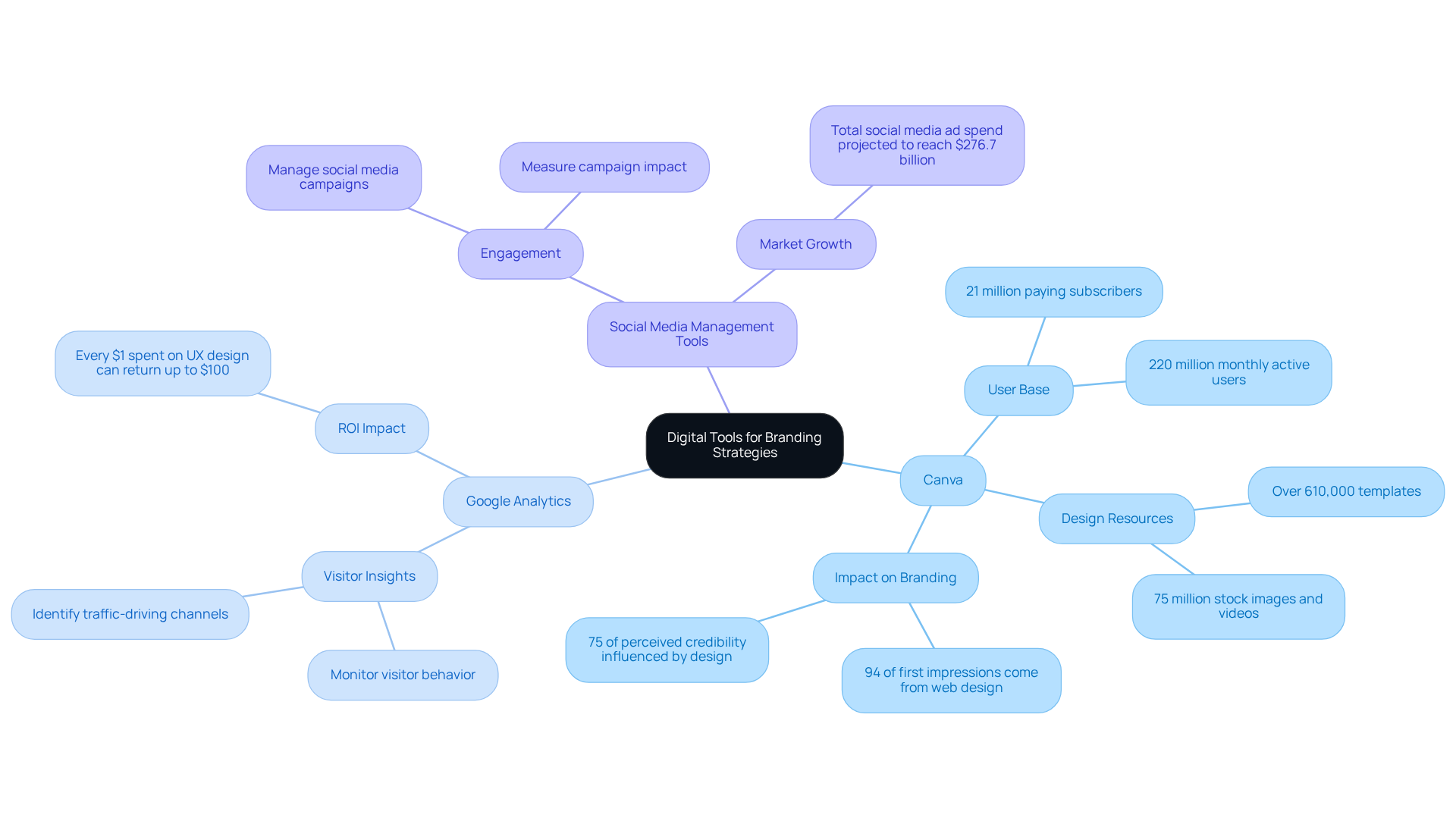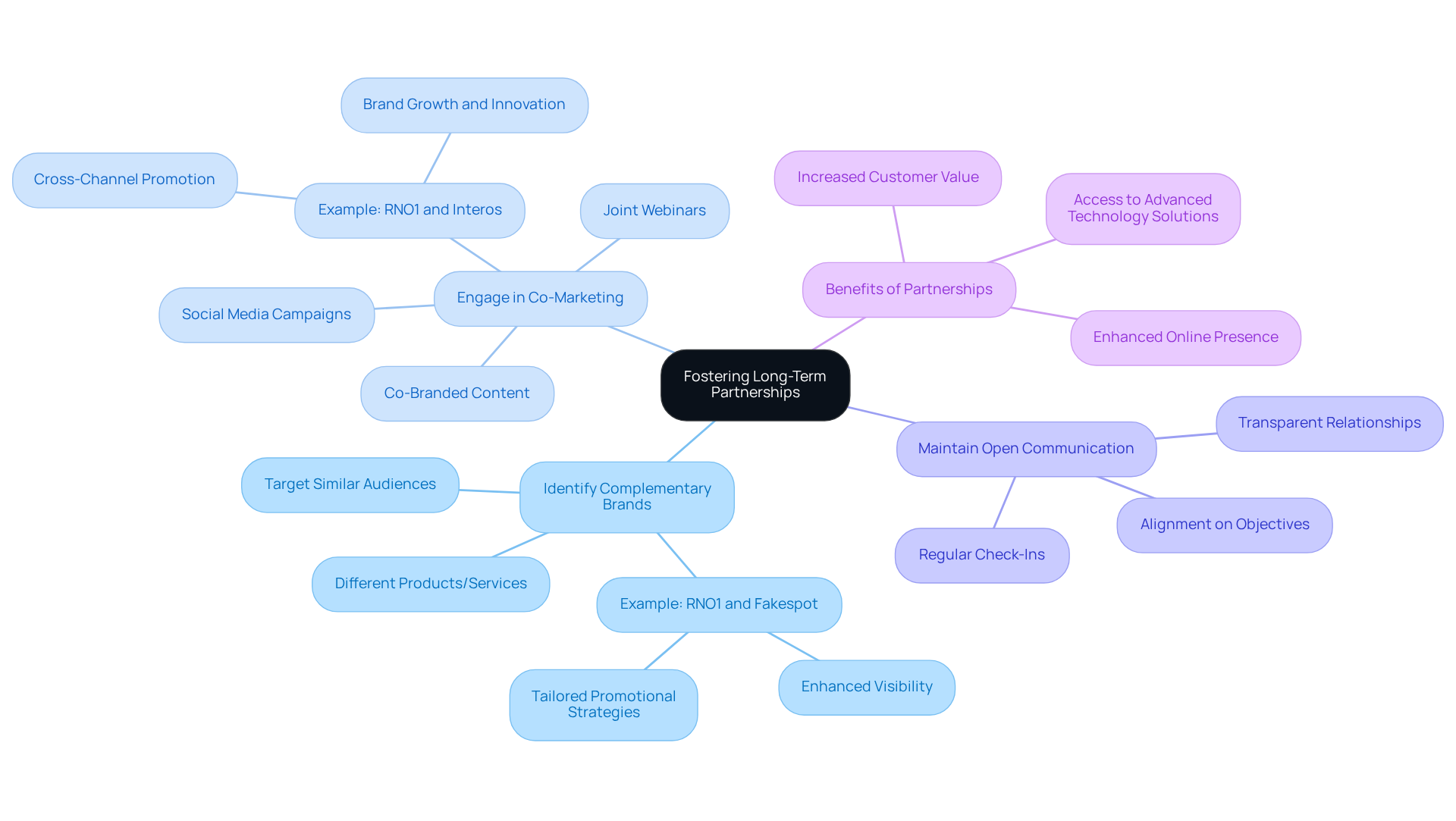Overview
The article highlights a common challenge that many startups face: establishing a strong web presence and brand identity. This can often feel overwhelming, leaving founders uncertain about how to effectively communicate their vision. The implications of struggling with web design and branding can be significant, leading to missed opportunities and a lack of connection with potential customers.
To navigate these challenges, the article outlines four best practices for effective web design and branding in startups. These core principles—simplicity, consistency, clarity, and user experience—serve as a foundation for creating a compelling online presence. By implementing actionable strategies and utilizing digital tools, startups can foster long-term partnerships and enhance their market presence.
Ultimately, these practices not only help in establishing a strong brand identity but also support the growth potential of startups. By focusing on these key areas, founders can feel more confident in their approach, knowing they are taking steps toward a successful future. Remember, you're not alone in this journey; many have walked this path and found success by embracing these principles.
Introduction
Startups often grapple with a significant challenge: carving out their identity in a crowded market. The pressure to create effective web design and branding can feel overwhelming, as these elements can truly determine their success. By embracing essential principles like simplicity, consistency, and clarity, these budding businesses can foster an online presence that truly resonates with their audience.
Yet, the path is not without its hurdles—how can startups ensure their branding not only captures attention but also nurtures lasting connections with users? Delving into best practices in web design and innovative branding strategies can illuminate the way forward, providing the support needed to navigate this intricate landscape.
Establish Core Principles of Web Design and Branding
Startups often find themselves grappling with the challenge of defining their identity, which encompasses mission, vision, and values. This foundational understanding of web design and branding is crucial, as it informs all design choices and sets the stage for success. It’s important to recognize that without a clear identity, startups may struggle to connect with their audience. Key principles to consider include:
- Simplicity: A clean, uncluttered design allows users to focus on essential brand elements. Statistics reveal that 70% of small business websites lack a clear call to action, leading to visitor confusion. By prioritizing simplicity in web design and branding, startups can enhance engagement and retention. RNO1 emphasizes web design and branding as a top-of-mind solution, ensuring that simplicity is at the forefront of every digital experience.
- Consistency: Utilizing consistent colors, fonts, and imagery across all platforms strengthens corporate identity. This approach not only enhances recognition but also fosters trust with individuals. RNO1's dedication to web design and branding ensures that every touchpoint embodies a unified image, which is essential for startups navigating the ever-changing digital landscape.
- Clarity: Clear and straightforward messaging enables users to quickly grasp what the company offers. Factors related to web design and branding contribute to 94% of initial impressions formed by visitors to a website, underscoring the necessity of clarity in communication. RNO1's focus on maximizing marketability through Return On Design & Digital (RODD) strategies further highlights the importance of clarity in identity.
To effectively apply these principles, startups can follow these supportive steps:
- Define Your Brand: Articulate your mission, vision, and values with clarity.
- Design with Purpose: Create a simple and consistent visual identity that truly represents your company.
- Communicate Clearly: Use straightforward language and visuals to convey your message.
For instance, Highline exemplifies effective branding through its minimalist design, which communicates its value proposition clearly. This strategy not only enhances audience engagement but also improves brand recall, demonstrating the power of simplicity in web design and branding. Moreover, with over 60% of web traffic originating from mobile devices, ensuring mobile optimization is essential for new businesses to connect with their audience effectively. By embracing these principles, startups can foster a strong identity that resonates with their audience and paves the way for lasting success.

Prioritize User Experience to Enhance Engagement
In the journey of building a successful startup, enhancing user experience can often feel overwhelming. Many founders struggle with web design and branding that resonates with their audience, leading to frustration and lost opportunities. It's essential to address these challenges with care and understanding.
One significant aspect to consider is Responsive Design. With over 50% of global web traffic coming from mobile devices, ensuring your website is mobile-friendly is crucial. A responsive design adapts seamlessly to various screen sizes, making it more accessible and enjoyable for users. Imagine how satisfying it feels when visitors can easily navigate your site, regardless of the device they use. This not only enhances their experience but also fosters a sense of connection with your brand.
Next, let’s talk about Intuitive Navigation. Simplifying navigation is vital for helping users find information quickly and effortlessly. When navigation is clear and logically structured, it significantly improves usability and engagement. Research shows that 94% of individuals consider simple navigation a key factor in their website experience. Take, for example, Cirkul's website; it exemplifies efficient intuitive navigation, allowing visitors to explore product offerings with ease. This thoughtful design keeps users engaged and encourages them to interact further with your offerings.
Additionally, Fast Load Times cannot be overlooked. Optimizing images and scripts is essential to ensure your pages load quickly. Studies reveal that even a one-second delay in loading can result in a 7% drop in conversions. This highlights how speed plays a critical role in retaining users and minimizing frustration. Picture the relief of your visitors as they experience a swift and seamless browsing journey.
By focusing on these vital elements of web design and branding, startups can create a compelling online presence that not only attracts visitors but also nurtures lasting engagement. Remember, you're not alone in this endeavor; many founders share similar experiences, and together, we can build websites that truly resonate with users.

Leverage Digital Tools for Innovative Branding Strategies
Startups often grapple with the challenge of establishing a strong brand identity through web design and branding in a crowded marketplace. This struggle can leave founders feeling overwhelmed and uncertain about how to effectively communicate their vision. However, by leveraging essential digital tools, they can alleviate some of these pressures and enhance their strategies in web design and branding.
-
Canva stands out as a beacon of hope for those without extensive design skills. This platform empowers users to create visually appealing graphics and marketing materials, making the design process accessible and enjoyable. With a community of over 220 million monthly active users, Canva offers an impressive collection of over 610,000 templates and design components. This wealth of resources can help new businesses with web design and branding to craft professional visuals swiftly and effectively, allowing founders to focus on what they do best.
-
Another invaluable resource is Google Analytics, a powerful tool that enables startups to monitor visitor behavior and gather insights that can shape their branding strategies. By examining data on interactions, founders can identify which channels drive the most traffic and conversions, leading to more efficient resource allocation. For instance, companies utilizing Google Analytics often witness a remarkable increase in their ROI, with every $1 invested in user experience design potentially generating up to $100 in return. This insight can be a game-changer for startups looking to refine their approach.
-
Additionally, Social Media Management Tools like Hootsuite or Buffer play a crucial role in managing and analyzing social media campaigns. These platforms empower new businesses to engage with their audience effectively and measure the impact of their efforts in web design and branding. With total social media advertising expenditure anticipated to reach $276.7 billion, these tools are essential for optimizing promotional strategies and ensuring that the brand resonates with its audience.
By thoughtfully integrating these tools, startups can create a cohesive strategy for web design and branding that not only enhances their visual identity but also optimizes their marketing efforts based on data-driven insights. For example, a new business that actively utilizes Google Analytics can pinpoint successful campaigns and refine their strategy, ensuring their branding connects meaningfully with their target audience. Yet, it’s vital for founders to customize their strategies and truly understand their audience to navigate potential pitfalls in their branding journey. Remember, every step taken towards understanding and connecting with your audience is a step towards building a brand that truly reflects your vision.

Foster Long-Term Partnerships for Sustainable Growth
Building enduring partnerships can be a daunting challenge for startups. Many founders struggle to navigate the complexities of collaboration, feeling overwhelmed by the competition and the need for visibility. This can lead to frustration and a sense of isolation, as the journey of entrepreneurship often feels solitary. However, there is hope and a path forward.
To foster meaningful connections, startups should first identify complementary brands. By seeking out companies that target similar audiences but offer different products or services, startups can create opportunities for collaboration. For instance, RNO1's partnership with Fakespot serves as a powerful example of how working with a performance promotion agency can enhance visibility and effectiveness through tailored promotional strategies.
Next, engaging in co-marketing initiatives can yield mutual benefits. Collaborating on joint webinars, co-branded content, or social media campaigns not only enhances visibility for both entities but also fosters a sense of community. RNO1's strategic alliance with Interos demonstrates the potential for cross-channel promotion to drive brand growth and innovation, leveraging RNO1's expertise in web design and branding.
Maintaining open communication is equally vital. Regularly connecting with partners ensures alignment on objectives and expectations, fostering a transparent and productive relationship. This approach is especially important for new businesses eager to leverage partnerships effectively.
Consider a tech startup collaborating with a digital promotion firm. Such a partnership can enhance online presence while simultaneously providing the agency access to advanced technology solutions. This symbiotic relationship not only strengthens brand presence but also drives innovation and growth for both parties. As Rick Currier wisely observes, "Partner promotion has become essential for scaling business reach and enhancing customer value." Research shows that 68% of organizations view partner marketing as essential, with 37% of marketing budgets allocated to these initiatives. This underscores the significant role partnerships play in the success of startups, offering a nurturing path forward for those willing to embrace collaboration.

Conclusion
Establishing a robust web design and branding strategy can feel overwhelming for startups striving to carve out their niche in a competitive market. The challenges of simplicity, consistency, and clarity can weigh heavily on founders. However, by focusing on these core principles, startups can create a compelling identity that genuinely resonates with their audience. These foundational elements not only guide design choices but also facilitate meaningful connections with users, ultimately driving engagement and fostering brand loyalty.
In this journey, several key practices can enhance a startup's online presence:
- Prioritizing user experience through responsive design, intuitive navigation, and fast load times is crucial; it ensures that visitors enjoy a seamless experience.
- Leveraging digital tools like Canva and Google Analytics can empower startups to craft professional visuals and make data-informed decisions, refining their branding strategies.
- Fostering long-term partnerships can amplify visibility and drive growth, highlighting the importance of collaboration in the entrepreneurial journey.
In a landscape where first impressions count, embracing these best practices is vital for startups to stand out and thrive. By implementing effective web design and branding strategies, founders can attract and retain their target audience, paving the way for sustainable success. Remember, the journey of building a brand is ongoing; continuous learning and adaptation are essential. Startups are encouraged to invest in their branding efforts, explore innovative tools, and cultivate partnerships that enhance their reach, ensuring their vision resonates with the world.
Frequently Asked Questions
Why is defining identity important for startups in web design and branding?
Defining identity, which includes mission, vision, and values, is crucial for startups as it informs all design choices and helps connect with their audience. Without a clear identity, startups may struggle to engage effectively with potential customers.
What are the key principles of web design and branding that startups should consider?
The key principles include simplicity, consistency, and clarity. These principles enhance user engagement, strengthen corporate identity, and ensure that messaging is easily understood by visitors.
How does simplicity impact web design and branding for startups?
Simplicity allows users to focus on essential brand elements and reduces confusion. Statistics show that 70% of small business websites lack a clear call to action, highlighting the importance of prioritizing simplicity to enhance engagement and retention.
What role does consistency play in a startup's branding?
Consistency in colors, fonts, and imagery across all platforms strengthens corporate identity, enhances recognition, and fosters trust with users. This unified image is essential for navigating the digital landscape.
Why is clarity important in web design and branding?
Clarity in messaging enables users to quickly understand what a company offers. Factors related to web design and branding contribute to 94% of initial impressions formed by visitors, making clarity essential for effective communication.
What steps can startups take to apply the principles of web design and branding?
Startups can define their brand by articulating their mission, vision, and values; design with purpose by creating a simple and consistent visual identity; and communicate clearly using straightforward language and visuals.
Can you provide an example of effective branding?
Highline exemplifies effective branding through its minimalist design, which clearly communicates its value proposition. This strategy enhances audience engagement and improves brand recall, illustrating the power of simplicity.
Why is mobile optimization important for startups?
With over 60% of web traffic originating from mobile devices, ensuring mobile optimization is essential for new businesses to effectively connect with their audience and provide a positive user experience.




